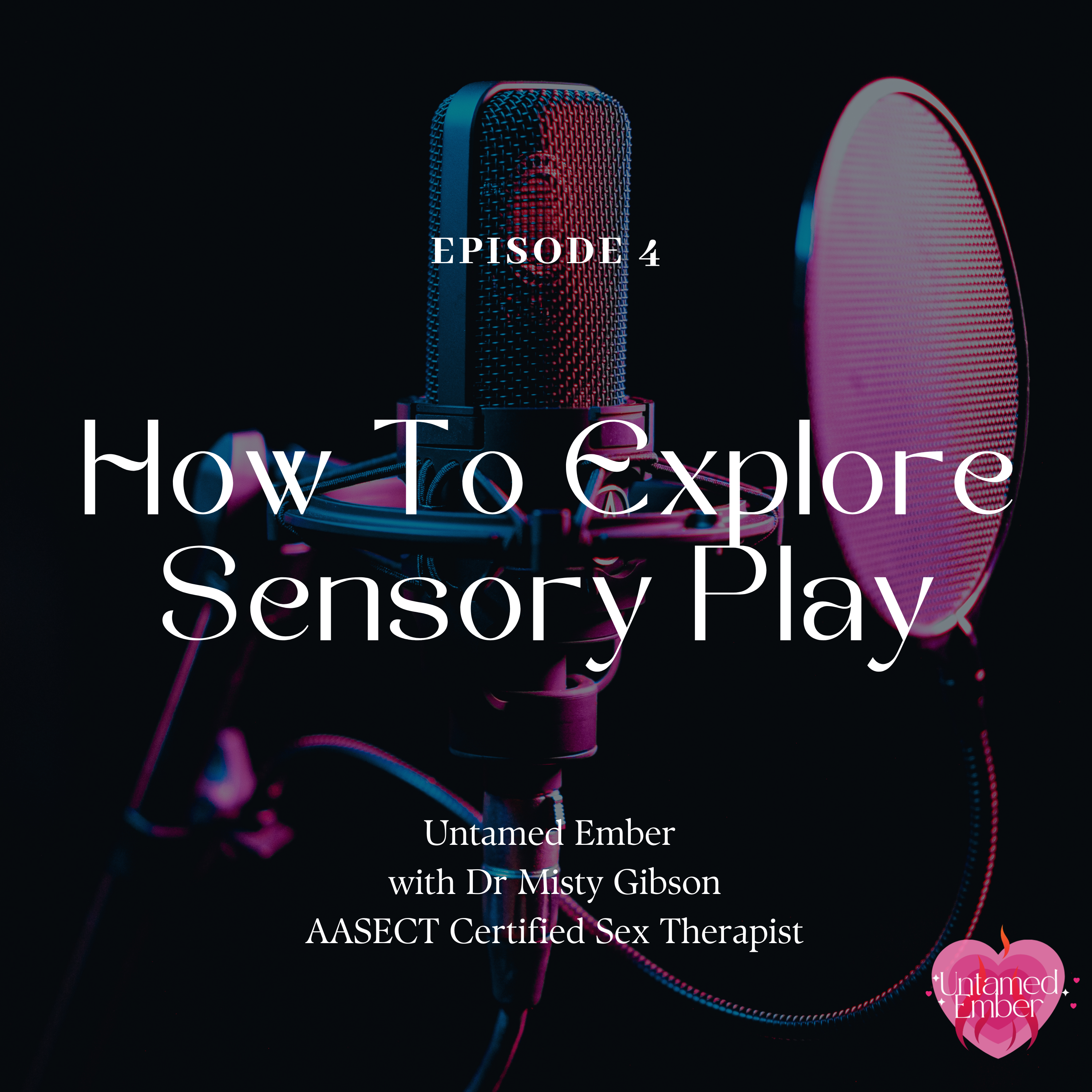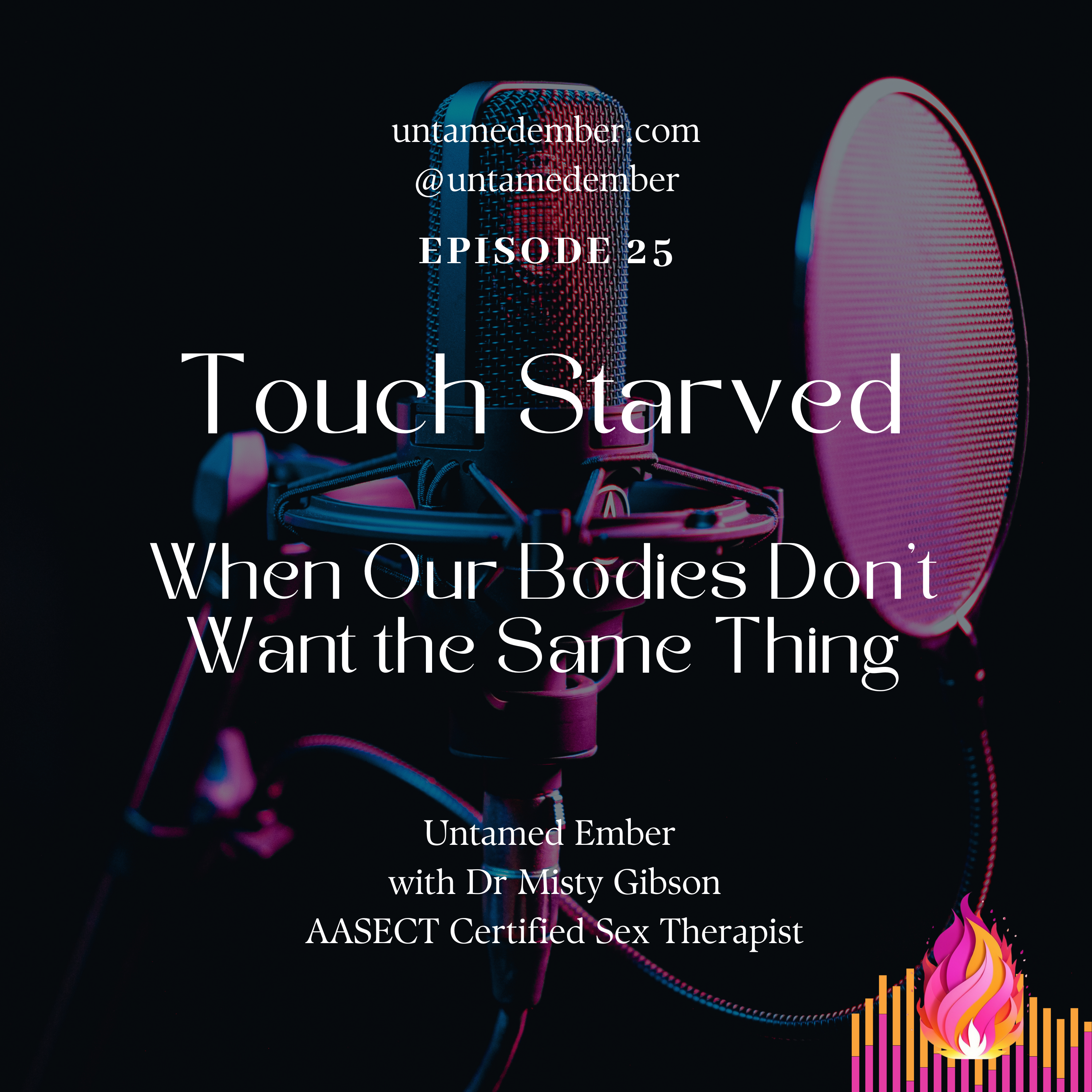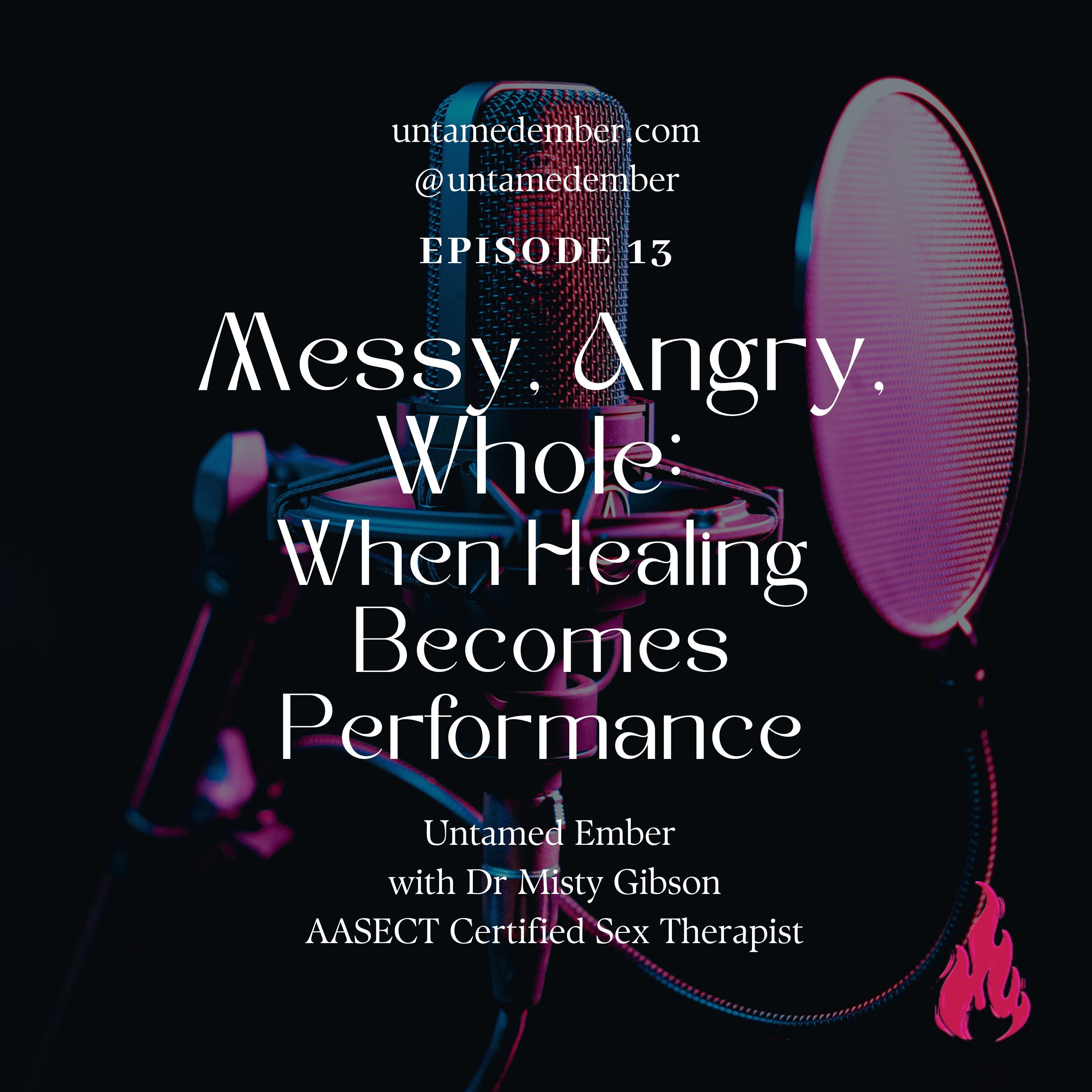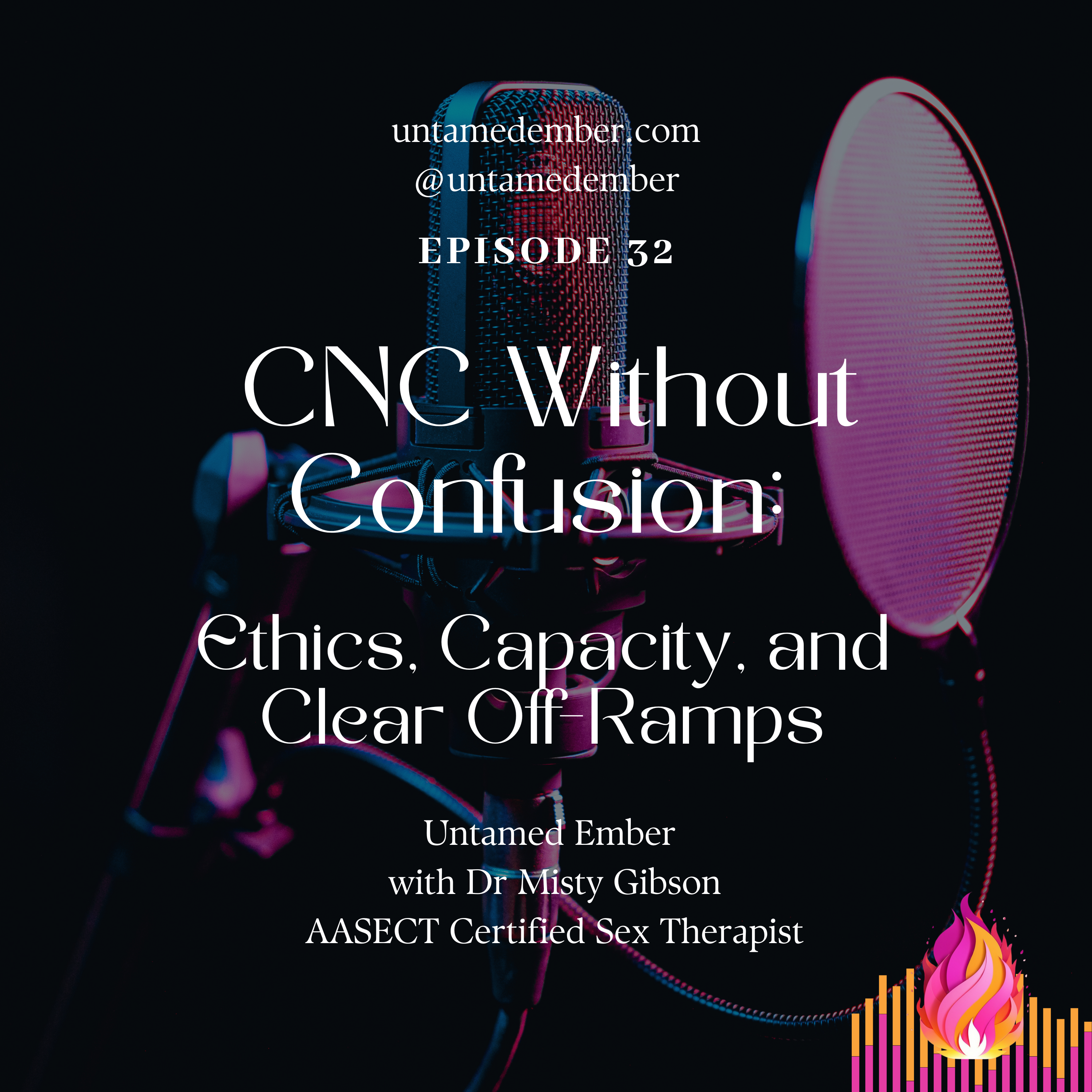Episode Transcript
[00:00:00] Foreign.
[00:00:11] Welcome back to Untamed Ember, the place where we strip away shame, unlearn what we've been told about pleasure, and dive into the delicious world of self discovery. I'm your host, Dr. Misty. And today we're going beyond just touch and into the full spectrum of pleasure. Because pleasure, it's a full body, multisensory experience.
[00:00:36] Let's look at some ideas. The scent of someone's skin. The sound of a whisper in your ear. The way silk, leather or bare skin feels against yours. You know that feeling pleasure is so much more than just one sense. It's an entire symphony of sensation. And when we learn how to play with this intentionally, that's when things get really interesting. Especially for us neurodivergent folks who feel senses so much more intense.
[00:01:21] So today we're talking About Sensory Play 101. How different sensory experiences shape desire. How to experiment with sensation safely. And why your brain absolutely loves a little variety. Let's dive in. Let's start with a little thought experiment.
[00:01:40] Picture someone lightly grazing their fingertips over your skin.
[00:01:45] Now imagine that same touch, but with ice.
[00:01:50] Now imagine it with warm breath instead.
[00:01:55] Same location, same pressure, but completely different sensations, completely different temperatures.
[00:02:04] That's because your brain processes touch differently, depending on the context. And not just touch. All of your senses contribute to how you experience pleasure. Let's break it down. Sight, the right lighting. The way someone looks at you. The colors, the movements, visual clues that turn you on.
[00:02:27] Sound, the tone of a voice, the way someone breathes. The sound of fabric against skin.
[00:02:35] Sound creates anticipation and deepens sensation.
[00:02:40] Smell, scent is directly tied to memory and arousal. Ever smelled someone's perfume or sweat and instantly felt something? That's your limbic system at work.
[00:02:52] Taste flavors can intensify sensation, whether it's mint, chocolate, wine or just the way someone's skin tastes.
[00:03:03] And then, of course, touch, which isn't just about contact, but about texture, temperature, and pressure.
[00:03:11] Most of us rely on one or two senses for pleasure. But what happens when we intentionally bring in more? That's where sensory play takes things to the next level.
[00:03:34] Okay, time to nerd out for a second.
[00:03:39] Did you know that your nervous system has different types of touch receptors?
[00:03:44] Some are designed for deep pressure, like a firm grip or a weighted blanket.
[00:03:50] Others respond to light, slow touch, like the way fingertips graze skin.
[00:03:56] And some pick up temperature changes, which is why hot and cold sensations feel so different.
[00:04:03] Your brain creates novelty. When you introduce a new sensation, your brain pays more attention. This is called sensory contrast, switching between light and Deep pressure. Brain wakes up playing with warm and cool. Brain is intrigued. Changing textures. Brain is like, ooh, what's happening here?
[00:04:26] This is why mixing sensation keeps pleasure from becoming routine. Your brain literally processes pleasure as more intense when it experiences. Experience is contrast.
[00:04:38] Now if you're wondering, okay, but how do I figure out which sensations work best for me? I got you over on Patreon. I've got a sensation mapping worksheet for this episode and it's basically a hands on guide to figuring out how different textures, temperatures, sounds and even scents impact your pleasure. There's a whole sensory play experiment where you get to try different sensations and track your reactions. Plus a sensory deprivation challenge to see what happens when you take senses away.
[00:05:12] If you want to geek out on sensation and actually practice this stuff, the link is in the show notes. You're going to love it.
[00:05:19] All right, let's get into how to actually play with sensation. Whether you're exploring solo or with a partner or partners, these are some easy and super fun ways to experiment.
[00:05:33] The first one is temperature play. Run warm breath over damp skin.
[00:05:39] Try ice cubes on the back of the neck, the inner wrists or the thighs.
[00:05:45] Use a warmed up massage oil for contrast.
[00:05:49] The second one is texture play. Silk, lace, leather, faux fur.
[00:05:54] Different textures change how touch feels. You can try a soft feather versus a firm hand. Your brain will love the contrast.
[00:06:04] Try to run a piece of jewelry or metal or beads over the skin for a cooler sensation.
[00:06:12] The third one is sensory deprivation. A blindfold can make every touch feel more intense.
[00:06:19] Noise canceling headphones can make you hyper aware of physical sensation.
[00:06:25] Try limiting one sense to amplify the others. This is also really excellent for neurodivergent folks who get overstimulated during sex. Take away some of those senses.
[00:06:36] Sound and voice play is another one. Experiment with whispering versus deep voice. Play with silence. Pause before speaking and see if that creates some tension.
[00:06:48] Use music to set the mood. Different rhythms change the pace of how you experience touch. And if you try different types of music, that might be really interesting too.
[00:06:59] A fifth way. Try scent and memory play. Scents trigger memory. Try essential oils, perfume or natural skin scent. Try associating a specific smell with a certain experience. Your brain will connect them over time.
[00:07:35] Okay, so sensory play is hot, but let's talk about doing it safely. This is really important. Especially whenever you have a neurodivergent partner that might get over stimulated. You don't want to push them into dissociation radiation. So the first thing, pay attention to sensory overload. If something isn't enjoyable, back off. Listen to your body. Overstimulation is real and different people have different thresholds, so really start to pay attention to yours. This is a great way to experiment so you can start to learn this about yourself.
[00:08:06] The second one Communication Preferences what feels good to one person might feel too intense to someone else? Ask first. Always make sure you have consent.
[00:08:17] The third thing Take your time. Sensory play is best when it's slow and intentional. No rushing, just exploration. Pleasure should always feel safe and enjoyable, so honor what feels best for your body and listen to your partner's needs.
[00:08:44] All right loves, that's your sensory play 101. We are bound to dive into this in a deeper level in a future episode. So for now I want to know which sense is your favorite when it comes to pleasure? Are you all about touch or do you do things like scent or sound to just play it up a little bit? Do you ever take away some of your senses just to see what that experience is like?
[00:09:09] Follow the Untamed Ember socials on Instagram, Facebook, TikTok and YouTube and check out our Patreon for the worksheets I mentioned.
[00:09:18] DM me on our socials. Leave a comment or tag me in your stories. I love hearing how you explore and if you're ready to dive deeper into pleasure sensory play, unlearning all the rules that don't serve you, come join the Untamed Ember community. The link is in the transcript.
[00:09:38] If you like this episode, I would love it if you start to help me build up this community. Since our podcast is new, subscribe, Leave a review Share it with someone who needs to hear it. Until next time, loves. Stay Untamed.




